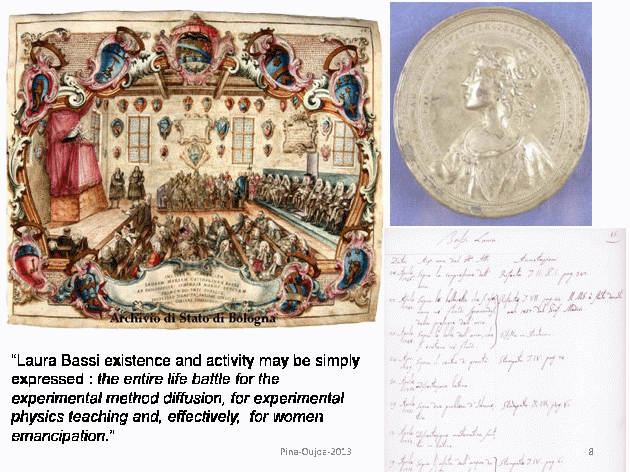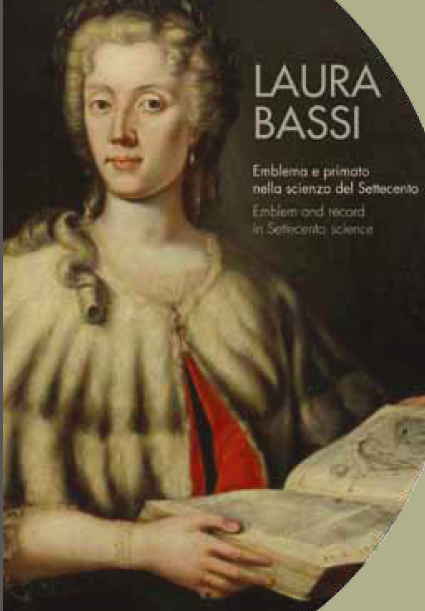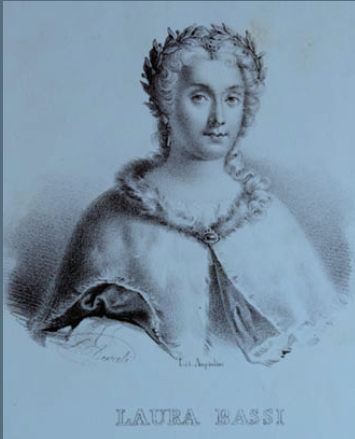WOMEN IN ITALY: YESTERDAY, TODAY AND TOMORROW
Giuseppina Maltoni
University of Bologna
maltoni@bo.infn.it
Lecture at the University of Oujda, Physics Dept., Oujda, Morocco, 4/6/2013
Abstract. A brief look at what women were, are and will be in Italy. The first University in the Western World started in Bologna in 1088, but opened up to women only three centuries ago thanks to the exceptional scientific talent of Laura Bassi (1711-1778).
Outline
- Introduction. Universities in Western Europe
- Laura Bassi, the first lady University Professor
- After Laura Bassi
- After world war 2 and the 1960 economic boom
- Today
- Tomorrow
- Conclusions
- Personal recollections
1. Introduction
Only three centuries ago, women in Italy had no rights, both socially and culturally. They could be very rich and have a good cultural background, but they could not be public teachers or professionals. Still not long ago, they were not admitted as University students; as a matter of fact only “studenti” were accepted, and the italian word is masculine! Then Universities were men’s worlds.
According to the “Conference” of European University Rectors, Bologna has the oldest university in the Western World. It was founded in 1080 by a school of jurists under Irnerio [1], who were studying and discussing the old codes of the Roman Law. The University, the Studium, started as a free law university. Soon other fields of study were added: logic, astronomy, medicine , philosophy, arithmetic, rhetoric, grammar, theology , hebraism, natural philosophy,….
Soon, students self organized in colleges and many students arrived from different parts of Europe: in the XII century there were 14 foreign colleges, among which il collegio spagnolo (spanish college) was rather important; the students from Italy grouped in 17 colleges. Many rich students came with servants; this became a reason for starting to enlarge many Bologna buildings with arcades over the streets, which in part explains so many porticos.
Table 1. Opening date of the first universities in Western Europe.
1088 Univ of Bologna, 1150 Paris, 1167 Oxford, 1209 Cambridge,
1222 Padova, 1224 Napoli, 1220-30 Salamanca, 1289 Montpellier,
1303 Roma, 1342 Pisa, 1347 Praga, 1364 Vienna, 1364 Krakau, 1385 Heidelberg,
… (some dates may be approximated).
At the beginning most lectures at the University of Bologna were held in the houses of the teachers. It took a considerable time before the lectures started to be held in a common building on the left side of S. Petronio Basilica, which was called Archiginnasio and still contains the beautiful first anatomy room.
The Bologna Academy of Sciences was started in 1700 in a new building in order to have scientific discussions and some modern research equipment.
Even this large building soon was not sufficient for all the activities and now the University is spread all over Bologna and in several neighbouring towns.
2. Laura Bassi, the first lady University Professor
Laura Maria Caterina Bassi was born in 1711 in Bologna; she came from a rich family and could afford to become a “real lady” and enjoy her life. But, since her childhood, she loved to study and to follow her curiosities in many fields, especially in science which was having a big boom in that time [2,3,4].
She learned Latin and French from a cousin priest. A medical doctor, G. Tacconi, professor at the University, while visiting Laura's mother, was impressed by the scientific curiosity of the young girl and started to teach her all the subjects treated in colleges and universities (reserved to men). Being surprised about Laura's learning, Tacconi invited his colleagues to examine the girl and they also were astonished. Even cardinal Lambertini (future pope Benedetto XIV) was so impressed by her talent that he convinced the entire Bologna Senate to accept her at the Bologna Academy of Sciences for one year.
At the end of that year she discussed 49 open theses including logic, metaphysics, psychology from both laic and ecclesiastic points of view; she gave extremely good explanations to all the questions and she obtained a “Laurea” recognition (Fig. 1b).
Later she gained a Honorary Chair for Universal Philosophy at the Academy of Sciences, but she could not teach at the University being a woman....; later on, her lectures could be accepted, but only after the authorization of her Superiors. (The lectures were always given in a very formal way, see Fig. 2).
Students from all over Europe came to Bologna for her lectures. Many families invited her in their homes for scientific discussions. But she worked mainly in her house where she organized a large physics experimental laboratory.
She had a scientific correspondence with many researchers all over Europe; also Alessandro Volta was in contact with her and received advices for his experiments).
In 1738 she married Giuseppe Veratti, a medical doctor and a physicist, who worked with her. In their house, they completed a private electricity laboratory for students. They had 8 children, (but only 5 of them survived).
In 1745, she was added as the 25th member of the Academy of Sciences, which admitted only 24 members, and the place was cancelled at her death.
Finally, in 1776 all the limitations for her public teaching were abolished and, thanks to the recognition of all her work in experimental physics, she became a “Full Professor” of Physics at the University of Bologna. (Only 4 writings of Laura Bassi arrived to us in the Bologna Academy of Sciences, see Fig 2 at bottom-right).
Just 2 years later, she died.
Her husband went on with the physics laboratory, but after his death everything was sold out by a nephew.
Laura Bassi was the first lady professor in the University of Bologna and, very probably, the first one in the world.
Only recently, some pieces and pictures of her lab were recovered in the Bassi-Veratti archives, and placed on-line in the web by the Stanford University library in collaboration with the “Biblioteca Comunale dell’Archiginnasio” of Bologna [5].
Laura Bassi’s name was not lost and many schools, streets and monuments in Bologna, in Italy and in Europe are dedicated to this exceptional lady. Lately, also a crater on the Venus planet was named after her.
|
|
|
Fig. 1a). Portrait of Laura Bassi from the Italian Physical Society (SIF) [4 ] . 1b) Portrait of Laura Bassi on her graduation day: note the laurel crown on her head.

Fig. 2. The official lectures by Laura Bassi were given in a rather formal way, as shown in the picture at top-left. The silver Medal of Laura is at top right. A short hand writing of Laura in Middle Age Latin is at the bottom right (from the Bologna Academy of Sciences).
3. After Laura Bassi
The opposition to women's emancipation continued all through the next century after Laura Bassi, even if some ladies are still acknowledged. Maria Gaetana Agnesi (1710-1799) was an important mathematician, but mainly at home. Clotilde Tambroni (1758-1817) gained the “cattedra” (chair) of “Fondamenti di lingua greca” and helped Maria Dalle Donne who in 1799 graduated in Medicine and, in 1804, opened the school for obstetricians. Even after the Universities of Paris and Zurich admitted women escaping from the east (because of the Jewish Diaspora), and the first lady veterinarian Stefania Kraszewiksaia graduated in 1889, the second one Dobrowiskaia graduated in 1893 (both went back to the east).
In Italy the situation in the veterinarian school was very heavy: the first veterinarian-lady was Jenny Barbieri, who graduated in 1927 at the Superior School of Bologna, and the second one arrived in 1950. (Let’s not forget that only 40 years later, in the academic year 1995-96 at the University of Bologna, over 70% of the persons graduated at the veterinarian faculty were women) [6,7].
A very hard field for women was also Engineering: the first lady engineer, Maria Bortolotti, graduated in 1918, at the end of world war one.
Things went much better for the fields were girls ended up as teachers in Elementary, Middle or High Schools.
Another big problem for women has always been the social class they belonged to (and I experienced this difficulty myself).
4. After world war II and the 1960 economic boom.
All the Universities, but mainly Faculties like Engineering, Medicine, Chemistry and Science had only male teachers....; females slowly entered as “assistants” in many departments for lab exercises.... and often, when the teacher was busy, they also gave lectures. Until 50 years ago, at the University, only men could aim to a good career; lately also women started to improve their positions.
In order to face the increasing number of students, Bologna became a multi-campus university, with 80000 students, including a Collegio Superiore, in Bologna; 20000 students in Ravenna, Forlì, Cesena and Rimini, plus a teaching site in Imola and a foreign site in Buenos Aires.
According to the 2011 classification of Higher Education Institutions, the Bologna University is classified as the 183rd of the world, and practically the best in Italy.
5 . Today
Today, in our universities, we have more female students than men, but there are still more men than women teachers, since many ladies leave the university when the “research work” becomes too demanding and incompatible with family charges. (Now, more than 90% of the teachers in all the schools before university are ladies).
Women, once treated as slaves, still have a lot to request beside the freedom of choosing their lives. Some of them are probably exaggerating and pretend too often “to have the last word”….but probably I am too old to judge modern times with an appropriate balance….
6. Tomorrow
The actual crisis is known by everybody, and women, who usually have more practical spirit seem to react better, even if they are still discriminated in finding jobs, which could depend on their long absence from work for each eventual pregnancy.
Just few days ago (may 28, 2013), one of the Italian Parliament House voted unanimously in favor of signing the Istanbul convention on “prevention, protection and justice” against violence toward women and this should help and be rather important for tomorrow!
All the efforts women had to face yesterday, made them strong enough to hold on. Some of their reactions may have gone too far, and could explain part of the violence we see today. This might be a good warning for tomorrow!
Let us hope that soon women will have nothing to envy to men and will be satisfied. It is time to transmit such ideals to young people and everyone should try to do his best to help future generations.
7. Conclusions
Recent news have been crowded with terrible violences on women, which even misogynist people consider quite unacceptable. Apparently, men are afraid to be overcome by women… All came out mainly in the last few decades. Just yesterday, women were completely dominated by men in every professional field. Soon after world war two, women woke up and started to fight in order to be recognized for all they had done and could do. Now, they are about to reach what they hoped for: the parity with the other sex! Is it too much? Then what can explain all the violence towards them?
Now, our female practical attitude should indicate to us a proper equilibrium with the other sex and a just way to reach a better life together, tomorrow.
It seems so simple to say, but it may still need a lot of work!
8. Personal recollections
I would like to end pointing out some events that I lived personally (as I am of the oldest generation).
At the end of the elementary school, I asked my teacher how I could continue the school and learn Latin (I wanted to know the meaning of the prayers that my grandmother- completely illiterate - tried to teach me. Today I would not need it, as prayers are in italian). I had no answer to my question and I did not want anybody in my family to know about my ideas for more school after elementary, while many children did not even finish it.
But, the head of the whole school, while delivering the diplomas in front of all the parents, reproached my mother for having grown in me the idea of going on to higher schools. Then she turned to me yelling that I was simply a girl and I belonged to a farm. There I should work to get my bread and, moreover, I had two brothers, younger than me, and they could, eventually, study to improve their land work. At that point, terribly ashamed in front of everybody, my mother started to cry and continued all the way back home, so the whole family, with uncles and aunts, had to be informed....everyone was really offended by the way we had been treated….so, all of them pushed me to try the admission test to the only school with Latin…. I passed the exam and I started my daily 13-14 km up and down, with the only bicycle in the house and unfriendly weather (there was no other way to go to school)….
Now, honestly, I must thank that “bad teacher” who started all this for me!
I faced hard trials in many ways, but everything went on successfully and I had good luck all the way…. I was aware that after High School I had to find a job. After the war, my family was poorer than before and I could not think of going to the University, as the closest one (Bologna), was 70 km away and taxes were unaffordable. Unbelievably, more luck arrived when I ended High School: for the first time the University of Bologna offered fellowships to women (…only 3) including free train tickets and free registration….fortunately I was informed just in time and I won one of them!..
More gymnastic exercise for me…. 4 hours daily travel by train and bike going to Bologna and coming back home to Forlì...
Weekends and holydays I worked for helping my family...but my main worry was not to loose the fellowship, as the rules were rather hard compared to the common trend.
At the end of the second year, the University, unexpectedly, improved the 3 female fellowships giving them the same treatment male students had….
Well, the three girls with the fellowship ended up into a very nice College downtown where everything was taken care of and were treated like princesses…..no more running up and down from town to town….no problems with rain and snow….Bologna is famous for its “porticos”.
Altogether, I believe that all the difficulties I had to face were a good exercise for my life, and gave me the energy to insist and go on, which greatly satisfied both me and my family....and now I am happy to be here!!
Acknowledgements
I would like to thank all the members of the Bologna-Oujda collaboration agreement, for their help and friendship.
References
[1] http://www.scienzagiovane.unibo.it/scienziati/aldrovandi-1.html Ulisse Aldrovandi
[2] http://www.scienzagiovane.unibo.it/scienziati.html, Laura Bassi.
[3] D. Noble, A world without ladies (Un mondo senza donne), tr.it. Bollati-Boringhieri, Torino, 1992.
[4] Laura Bassi: Emblem and primacy in Settecento science, Ed. by L. Cifarelli and R. Simili, Editrice Compositori, ISBN 978-88-7794-774-1 (2012).
[5] Bassi-Veratti arxives on line (From the Stanford-Bologna library collaboration).
[6] Elio Melli, Laura Bassi Veratti: ridiscussioni e nuovi spunti in: AA.VV., Alma Mater Studiorum. La presenza femminile dal XVIII al XX secolo, Bologna, 1988, p. 71-79.
[7] Alba Veggetti, Veterinaria al femminile, Atti V Convegno nazionale di Storia della Medicina Veterinaria, n° 71 Collana Fondazione iniziative Zooprofilattiche e Zootecniche, Brescia, 2008, p.167-173.

